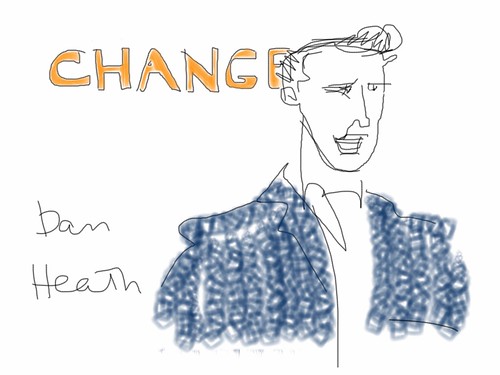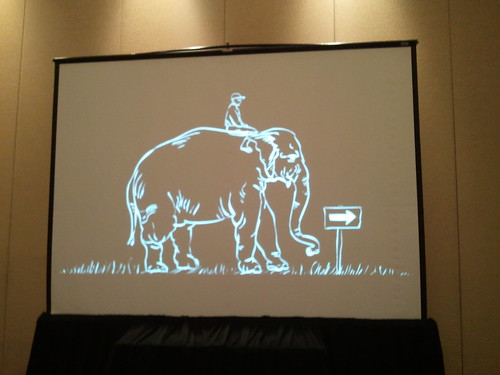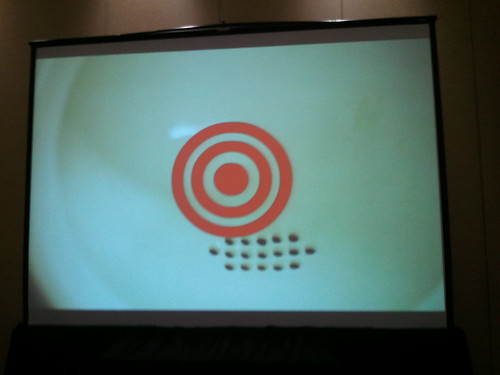
The Friday plenary session at the NTC featured Dan Heath, Co-Author of Flip the Switch, and was all about organizational change.
Holly warmed up the crowd with a humorous slide show about the Internet connectivy. This year 2008 people are in attendance, the most ever. Also new this year is the online NTC. She gave a quick update on NTC and thanked everyone including, staff, the community, and sponsors.
How great it is to be in a room with everyone. Want to do more. Help support local connections with other nonprofit techies. Donate Tweets and Facebook posts to NTEN and use it to fund local 501 C-3 Clubs and local gatherings around the country.
The one question: How do I convince my boss and co-workers to get on the train with us? Holly recognized some “heros” in the community who have done that. Ruck Sack, DoSomething, Ada Jenkins, They have the instigator gene – they have the ability to make it happen. Only 4 out of every 10 tech-responsible staff report to leadership. How many of you report to the Finance Director? And they let you spend money on technology?
Everyone will pledge will change one mind in their organization. Getting that new email system, update web site, or the cloud. We want every nonprofit to have a seat on the leadership table at organizations.
Akhtar Badshah, Microsoft, introduced the keynote speaker, Dan Heath, co-author of Switch: How to Change Things When Change is Hard.
Change is a four-letter word. “Change is hard.” Most often brought up. We struggle with various types of change. This can’t be the whole story. He showed examples when change comes joyfully, like weddings and having children. He talked about changes in technology and fashion.
Why is change hard sometimes and sometimes easy? That’s what lead them to write the book.
Science: What does psychology tell us about change? It has to be with a split of our brain. He used the metaphor of our good intentions of going on a diet and not being able to stick to it. It is the way we’re wired. There are two parts of our brain, the rational and the emotional. They don’t agree and it isn’t a fair fight. The emotional part of our brains is like an elephant. The elephant gives the passion, drive, and the “wouldn’t it be cool if …” The elephant is the part of us that says let’s move. The elephant is the fuel for action and change.
How to make change easier: A Three-Part Framework
1.) Direct the Rider
Bad is stronger is than good. How many people call you to ask for help in analyzing why a relationship is not working versus working. We rarely train our analytical capacity to what is working. Why do obsess about projects that fail and not those that work? The most important question is to focus on what is working. He suggests looking for the bright spots – the projects that work. Analyze the ingredients of success of projects that went smoothly. He asked: Can you find your own bright spot?

2.) Motivate the Elephant (comes from feeling)
Change is sparked by feeling, not information. Our first instinct is to give people information. He gave examples from cigarette and nutrition labels. He also shared some corporate examples of change. The examples made the point: Your colleagues will change if they feel something. We have the wrong mental model for change. We think it happens likes: Analyze, Think, Change. It rarely happens that way: See, Feel, Change.
If you have an idea about how to make something in your organization better, think about what you can show people in your organization. Change starts with seeing it!
Next comes the feeling. This is especially important for donors. We’re good at pity – starving kids, etc. It has a side effect – we can’t take too much of that. He showed a series of photos from the Common Ground campaign for homeless to get homes – before and after photos. He pointed out that it was story of hope.
3.) Shape the Path (create a culture for change)
Make it easy to give. He talked about a test using a food drive with two sets of instructions, one complicated and one simple. Guess which one got better results?
It is easier to change the situation than the person. He gave an example of a company needing to switch from paper form to online form. They discovered that people were annoyed by the wizard. They were not resistant to change, but busy. If they could do it easier and faster, they’d do it.
How can you shape a path for your change?

Aim problem in the men’s bathroom in the Amsterdam. They fixed it by etching a house fly in the urinal. He demonstrated how this concept resonates with the male way of thinking using the visual above.
Finally, if you want change, failure is part of the deal. The struggle is important. It isn’t about creating plan and executing the plan and it’s perfect. We have to give ourselves permission to fail. Think back when your children learned to walk. If your child stumbled on their first step, would you say forget about walking. To accomplish something great, it requires struggle. The struggle that comes with change and the adaptation that happens.
Lots of inspiration to take back to your practice, organization, and work about creating change.
Beth Kanter is a consultant, author, influencer. virtual trainer & nonprofit innovator in digital transformation & workplace wellbeing.
